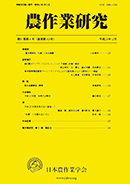All issues

Volume 51 (2016)
- Issue 4 Pages 131-
- Issue 3 Pages 101-
- Issue 2 Pages 39-
- Issue 1 Pages 1-
Volume 51, Issue 4
Displaying 1-8 of 8 articles from this issue
- |<
- <
- 1
- >
- >|
Research paper
-
Takuo Kokuryu, Hiroyuki Tsuji, Yukinori Shibuya, Katsufumi Wakabayashi2016Volume 51Issue 4 Pages 131-142
Published: 2016
Released on J-STAGE: June 01, 2017
JOURNAL FREE ACCESSWe developed a method of zig-zag planting of potato using commercial Japanese-made planters and examined its accuracy. Also, we cultivated potatoes in a field by zig-zag planting using improved zig-zag planters and an improved rotary hiller. The new commercial Japanese-made planter uses a newly developed blade to apportion seed potatoes in a zig-zag pattern. The device is placed below the seed-feeder of a commercial potato planter. We also improved the furrow-opener, press-roller, soil-coverer, and their attachments. With our semi-automatic zig-zag potato planter, seed potatoes are apportioned by using the potato's own weight; with our automatic planter this is done through connection to a drive wheel. The tine position on the commercial rotary hiller used was changed to avoid injury to seed potatoes just ridged after planting. The distance between fertilizer rows in zig-zag planting is 660 mm-shorter than in conventional planting (750 mm). Seed potatoes are planted on either side of the fertilizer row at 150-mm spacings. Just after planting, the soil is earthed-up at 1500-mm intervals, which include two fertilizer and four planting rows. Field experiments showed that both semi-automatic and automatic planters enabled zig-zag planting at the same regular working speed (3-4 km/h) as with a commercial planter. Planting accuracy with the automatic planter was comparable to that of conventional planters, but that with the semi-automatic planter was less than with conventional ones. In zig-zag planting, both number of tubers per plant and thus per-area yield of potatoes weighing 60 g or more were greater than with the conventional method. However, after a certain point of increase in tuber number per plant, potato size and weight tended to decrease. In addition, earthing-up with a rotary hiller had a problem whereby the tines of the hiller touched the seed potatoes, causing them to green.View full abstractDownload PDF (2273K) -
Tomomichi Mizukami, Takanobu Yoshida, Sumihiko Miyahara2016Volume 51Issue 4 Pages 143-153
Published: 2016
Released on J-STAGE: June 01, 2017
JOURNAL FREE ACCESSDiseases and pests need to be controlled to prevent damage to agricultural crops and achieve a stable supply of food. It is important to control spraying of agricultural chemicals that aid in the prevention of diseases and pests. Therefore, the use of riding vehicles for crop management is required to ensure adequate and even spraying. Hence, the relationship between the boom height of the sprayer and even application of the pesticide was studied. The following results were obtained from a riding obstacle test. We determined that the IQR (inter quartile range) increased 351% for a water distribution test and the IQR increased 20% for an application test. Additionally, we show the relationship between boom heights and application using a gamma distribution of a generalized linear model based on a wind tunnel test. The study indicated that a lack of uniformity of the boom height created uneven application when using riding vehicles for crop management. We concluded that uniformity of boom height acts to reduce uneven application.View full abstractDownload PDF (2247K)
Comment
-
[in Japanese]2016Volume 51Issue 4 Pages 155-156
Published: 2016
Released on J-STAGE: June 01, 2017
JOURNAL FREE ACCESSDownload PDF (661K)
Voice
-
[in Japanese]2016Volume 51Issue 4 Pages 159
Published: 2016
Released on J-STAGE: June 01, 2017
JOURNAL FREE ACCESSDownload PDF (544K) -
[in Japanese]2016Volume 51Issue 4 Pages 160
Published: 2016
Released on J-STAGE: June 01, 2017
JOURNAL FREE ACCESSDownload PDF (543K) -
[in Japanese]2016Volume 51Issue 4 Pages 161
Published: 2016
Released on J-STAGE: June 01, 2017
JOURNAL FREE ACCESSDownload PDF (546K) -
[in Japanese]2016Volume 51Issue 4 Pages 162
Published: 2016
Released on J-STAGE: June 01, 2017
JOURNAL FREE ACCESSDownload PDF (529K) -
[in Japanese]2016Volume 51Issue 4 Pages 163-164
Published: 2016
Released on J-STAGE: June 01, 2017
JOURNAL FREE ACCESSDownload PDF (602K)
- |<
- <
- 1
- >
- >|